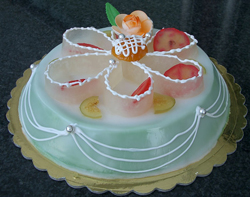Facts About Cassata
Cassata, or cassata siciliana, is a delightful traditional dessert originating from Sicily, Italy. Picture a round sponge cake soaked in fruit juices or liqueur, layered with creamy ricotta cheese and candied fruit, then elegantly covered with marzipan and adorned with pink and green icing in decorative patterns. Tempting, right? And there's more—cassata can also refer to a type of Neapolitan ice cream studded with candied or dried fruits and nuts.
The origins of cassata can be traced back to the 10th century in Palermo, during the period of Muslim rule. The term "al-qaššāṭī" first appeared in Corleone in 1178. As for the name "cassata" it might derive from the Arabic word "qas'ah" or the Latin "caseāta." According to historian John Dickie, cassata didn't take the form we recognize today until the 18th century.
Cassata comes in various shapes and sizes. You might find it in rectangular, square, or even box shapes. In Catania, there's a unique version called Cassata Catanese, which is made like a pie. For something smaller, try the Cassatella di Sant'Agata, a mini version topped with a candied cherry.
In the United States, cassata has its own regional variations. In Cleveland, for instance, there's a version featuring sponge cake soaked in syrup, layered with strawberries and custard, and finished with a generous layer of whipped cream. Meanwhile, in Portland, Oregon, cassata takes the form of a coffee liqueur-soaked cake filled with espresso and ricotta.
Even in India, cassata has found a home, albeit in a different form, referring to a delectable layered ice cream. Imagine pistachio, vanilla, and strawberry flavors stacked on a base of sponge cake, all topped with crunchy nuts.
No matter where you find it, cassata is a sweet treat that brings a bit of Sicilian tradition to dessert tables around the world.

 Slovenia
Slovenia